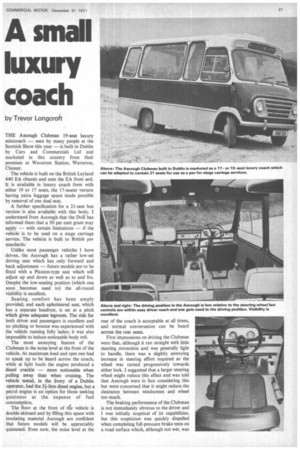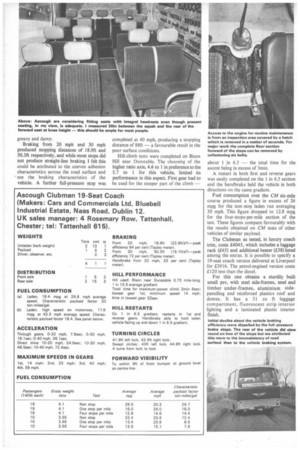A small luxury coach
Page 29

Page 30

If you've noticed an error in this article please click here to report it so we can fix it.
by Trevor Longcroft
THE Ascough Clubman 19-seat luxury rninicoach — seen by many people at the Scottish Show this year — is built in Dublin by Cars and Commercials Ltd and marketed in this country from their premises at Waverton Station, Waverton, Chester.
The vehicle is built on the British Leyland 440 EA chassis and uses the EA front end. It is available in luxury coach form with either 19 or 17 seats, the 17-seater version having extra luggage space made possible by removal of one dual seat.
A further specification for a 21-seat bus version is also available with this body. I understand from Ascough that the DoE has informed them that a 50 per cent grant may apply — with certain limitations — if the vehicle is to be used on a stage carriage service. The vehicle is built to British psv standards: Unlike most passenger vehicles I have driven, the Ascough has a rather low-set driving seat which has only forward and back adjustment — future models are to be fitted with a PIaxton-type seat which will adjust up and down as well as to and fro. Despite the low-seating position (which one soon ,becomes used to) the all-round visibility is excellent_ Seating comfort has been amply provided, and each upholstered seat, which has a separate headrest, is set at a pitch which gives adequate legroom. The ride for both driver and passengers is excellent and no pitching or bounce was experienced with the vehicle running fully laden; it was also impossible to induce noticeable body roll.
The most annoying feature of the Clubman is the noise level at the front of the vehicle. At maximum load and rpm one had to speak up to be heard across the coach, while at light loads the engine produced a diesel crackle — more noticeable when pulling away than when cruising. The vehicle tested, in the livery of a Dublin operator, had the 24-litre diesel engine, but a petrol engine is an option for those seeking quietness at the expense •of fuel consumption. The floor at the front of tee vehicle is double-skinned and by filling this space with insulating material Ascough are confident that future models will be appreciably quietened. Even now, the noise level at the rear of the coach is acceptable at all times, and normal conversation can be heard across the rear seats.
First impressions on driving the Clubman were that, although it ran straight with little steering correction and was generally light to handle, there was a slightly annoying increase in steering effort required as the wheel was turned progressively towards either lock. I suggested that a larger steering wheel might reduce this effect and was told that Ascough were in fact considering this but were concerned that it might reduce the clearance between windscreen and wheel too much.
The braking performance of the Clubman is not immediately obvious to the driver and I was initially sceptical of its capabilities, but this scepticism was quickly dispelled when completing full-pressure brake tests on a road surface which, although not wet, was greasy and damp.
Braking from 20 mph and 30 mph produced stopping distances of 18.9ft and 50.3ft respectively, and while most stops did not produce straight-line braking I felt this could be attributed to the uneven adhesion characteristics across the road surface and not the braking characteristics of the vehicle. A further full-pressure stop was
completed at 40 mph, producing a stopping distance of 88ft a favourable result in the poor surface conditions.
Hill-climb tests were completed on Bison Hill near Dunstable. The choosing of the higher ratio axle, 4.6 to 1 in preference to the 5.7 to 1 for this vehicle, limited its performance in this aspect. First gear had to be used for the steeper part of the climb about 1 in 6.5 the total time for the ascent being in excess of 3min.
A restart in both first and reverse gears was easily completed on the 1 in 6.5 section and the handbrake held the vehicle in both directions on the same gradient.
Fuel consumption over the CM six-mile
course produced a figure in excess of 26 mpg for the non-stop laden run averaging
30 mph. This figure dropped to 12.8 mpg for the four-stops-per-mile section of the test. These figures compare favourably with the results obtained on CM tests of other vehicles of similar payload.
The Clubman as tested, in luxury coach trim, costs £4045, which includes a luggage rack (£45) and additional heater (£38) listed among the extras. It is possible to specify a 19-seat coach version delivered at Liverpool for £3916. The petrol-engined version costs £120 less than the diesel.
For this one obtains a sturdily built
small psv, with steel side-frames, steel and
timber under-frames, aluminium sidepanelling and reinforced plastics roof and
domes. It has a 31 cu ft luggage compartment, fluorescent strip interior lighting and a laminated plastic interior finish.












































































